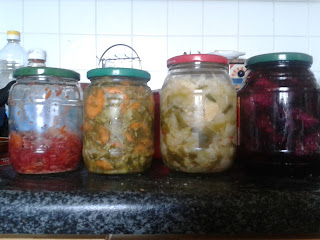 |
| View of our west facing window, cucumber plants |
I am going to share the best (most fool proof) yeast bread
recipe that I have ever used with you. It is adapted from a post by the blog Chickens in the Road, where it is
called Grandmother bread.
To make 2 medium sized loaves
3 cups liquid, gently heated to body temperature (water,
whey, buttermilk, milk or kefir will work),
to this add 2tbs sugar, 10g yeast and 2tsp salt. Wait for 5
mins till the yeast goes fluffy before adding 3 of the 7 cups of flour. Work
the 3 cups of flour in with a stiff wooden spoon and add more flour gradually
until a nice, non soggy ball of dough is achieved. At this time, add your extra
options such as half a cup of linseed and half a cup of wheatgerm or oat bran
or anything to hand that will add fiber and nutrition to the bread. Knead the dough on a lightly floured surface
till such time as it stops being sticky and it looks more elastic than the
dough you started with (this will take 12-15 minutes). Put it in a bowl and
leave in a warmish spot till the dough doubles in size. Grease your loaf tins
and punch the dough down, form it into loaves so that it sits half way to two
thirds of the way up the tin. Any surplus can be formed into rolls, or twists
or whatever you like. Allow the dough to rise again till it doubles in size.
Preheat the oven to 180 degrees and gently transfer your dough into the oven
without knocking or bumping it, you don't want any of the air to escape from
the loaf at this point as it will result in a heavy loaf. Spray some water into
the oven when you put your loaves in and again a minute later, this will allow
the dough to expand in the heat a bit without being hindered by the forming
crust. This will also result in a crisper crust. Bake for 25 to 35 minutes, remove to a wire
rack, and remove the tin, knock the bottom of the loaf as if knocking on a
door, the sound should be fairly hollow (Thwackable as the bread experts say)
If it does not sound right (this comes with practice) return it to the oven and
turn the oven off. Let it cook in the
residual heat for 15 minutes or so. By the way, do not be tempted to eat your
bread fresh out of the oven, it is still cooking and its proteins are still
changing and setting. It will still be warm after 45 mins when it would be a
safe time to tuck into it.
At- a- glance guide to making “Grandmother” bread
 |
| Where the mixed seeds were planted |
Ingredients
3 cups liquid
2tbs sugar
2tsp salt
10g yeast
7 cups flour
Optional extras
linseed
wheatgerm
oat bran
Method
Heat liquid to blood temperature
Add sugar, salt and yeast, wait 5 mins for yeast to fluff up
Add 3 cups flour, stir in
Add rest of flour gradually, mixing it in as you go
Add optional extras
Knead it out on a lightly floured surface for 12-15 mins
Place in a bowl with a lid
(cling film) till it doubles in size
Punch dough down, form into loaves
Allow dough to rise up again
Preheat oven to 180 degrees
Gently transfer to oven
Spray inside oven with water
Let bread cook for 25-35 mins
Check for thwackablility
Let loaves rest for 45 mins as they cool
 |
| The south facing wall |
Enjoy with butter!

We live in an apartment type dwelling surrounded by concrete.
So this year, I decided to actively make our neighbourhood prettier using
plants. This first area tackled was the walk up to the apartment, there was
some soil there (hard and compact) and this was raked one night in April and a
mixed bunch of seeds planted. Thus far, a calendula, a dill plant and a cosmos
plant have come up. So exciting. The next task was to deal with the south
facing wall adjacent to the houses (apartments) So, the fishbox that was
already there got appropriated (filled with soil and then with surplus plants,
mainly beans, nasturtiums, a lettuce, a lady's mantel and some sweetpea. And
another fishbox was added. I know that the fishbox is the property of someone
else, but they let said fishbox wash up on the shore, and become litter on the
beach. So I de-littered the beach by removing it. (If someone wants it back,
they can come and get it) Anyway, this one was planted up with sunflowers (I
never would have guessed that sunflowers are such thirsty creatures) and bush
beans (dwarf french beans). My next project is to spread the word that this is
free food for the neighbourhood. I am not entirely sure how to go about this,
perhaps a handmade flyer to each house. I have also planted up some shopping
bags with sweetpea, sunflowers, zinnia and runner beans, these stand guard
beside the door leading to our
apartment. (The landlord swung by a few weeks ago and made a comment on all the
plants growing, my immediate response to him was “its lovely isn't it?” and he
could not help but agree)
This week, I had access to a load of broad beans that had
passed their best.
So I spent some time removing the beans from their pods, and
simmering them for 20 or so minutes till soft. These are now in the freezer
ready to turn into hummus.
Broad bean hummus
Lightly cooked broad beans, mashed and thrown into food
processor with:
Garlic
Lemon juice
Olive oil
Salt
Pepper
Tahini is optional I think
Blitz till a nice consistancy is reached.
Refrigerate and use within 3 days






